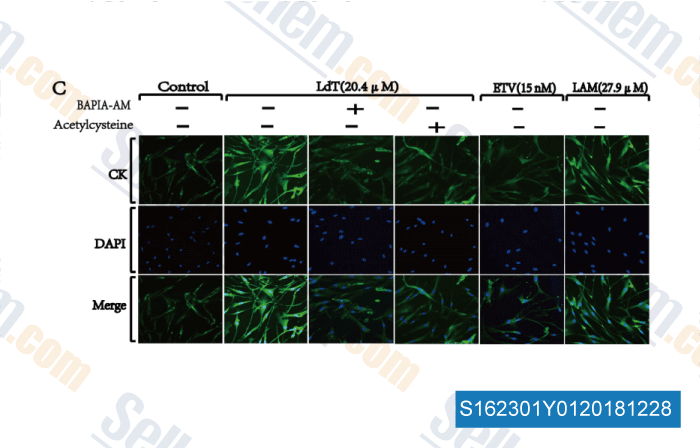|
Toll Free: (877) 796-6397 -- USA and Canada only -- |
Fax: +1-832-582-8590 Orders: +1-832-582-8158 |
Tech Support: +1-832-582-8158 Ext:3 Please provide your Order Number in the email. |
Technical Data
| Formula | C5H9NO3S |
||||||
| Molecular Weight | 163.19 | CAS No. | 616-91-1 | ||||
| Solubility (25°C)* | In vitro | DMSO | 33 mg/mL (202.21 mM) | ||||
| Water | 33 mg/mL (202.21 mM) | ||||||
| Ethanol | 33 mg/mL (202.21 mM) | ||||||
| In vivo (Add solvents to the product individually and in order) |
|
||||||
|
* <1 mg/ml means slightly soluble or insoluble. * Please note that Selleck tests the solubility of all compounds in-house, and the actual solubility may differ slightly from published values. This is normal and is due to slight batch-to-batch variations. * Room temperature shipping (Stability testing shows this product can be shipped without any cooling measures.) |
|||||||
Preparing Stock Solutions
Biological Activity
| Description | Acetylcysteine (N-acetyl-l-cysteine, NAC,N-acetylcysteine) is a ROS(reactive oxygen species) inhibitor that antagonizes the activity of proteasome inhibitors. It is also a tumor necrosis factor production inhibitor. Acetylcysteine(N-acetyl-l-cysteine) suppresses TNF-induced NF-κB activation through inhibition of IκB kinases. Acetylcysteine(N-acetyl-l-cysteine) induces apoptosis via the mitochondria-dependent pathway. Acetylcysteine(N-acetyl-l-cysteine) inhibits ferroptosis and virus replication.Solutions are unstable and should be fresh-prepared. | ||||
|---|---|---|---|---|---|
| Targets |
|
||||
| In vitro | N-acetylcysteine inhibits activation of c-Jun N-terminal kinase, p38 MAP kinase and redox-sensitive activating protein-1 and nuclear factor kappa B transcription factor activities regulating expression of numerous genes. N-acetylcysteine can also prevent apoptosis and promote cell survival by activating extracellular signal-regulated kinase pathway, a concept useful for treating certain degenerative diseases. N-acetylcysteine directly modifies the activity of several proteins by its reducing activity. [1] N-acetylcysteine prevents apoptotic DNA fragmentation and maintains long-term survival in the absence of other trophic support in serum-deprived PC12 cells. N-acetylcysteine also prevents death of PC12 cells and sympathetic neurons. [2] N-acetylcysteine causes dose-dependent reductions in viability in rat and human aortic smooth muscle cells. [3] N-acetylcysteine activates the Ras-extracellular signal-regulated kinase (ERK) pathway in PC12 cells. N-acetylcysteine protects neuronal cells from death evoked by withdrawal of trophic support. N-acetylcysteine increases nitric oxide (NO) release from protein-bound stores in vascular tissue. N-acetylcysteine pretreatment of PC12 cells interferes with NGF-dependent signaling and neurite outgrowth, and it was suggested that NAC interferes with redox-sensitive steps in the NGF mechanism. [4] |
||||
| In vivo | N-acetylcysteine improves cognition of 12-month-old SAMP8 mice in both the T-maze footshock avoidance paradigm and the lever press appetitive task without inducing non-specific effects on motor activity, motivation to avoid shock, or body weight. [5] |
Protocol (from reference)
| Cell Assay: |
|
|---|---|
| Animal Study: |
|
References
Customer Product Validation

-
Data from [Data independently produced by , , Biochem Pharmacol, 2017, 146:224-232]
Selleck's Acetylcysteine (N-acetylcysteine) has been cited by 234 publications
| Inhibition of DEK restores hematopoietic stem cell function in Fanconi anemia [ J Exp Med, 2025, 222(3)e20241248] | PubMed: 39836085 |
| Pifithrin-μ sensitizes mTOR-activated liver cancer to sorafenib treatment [ Cell Death Dis, 2025, 16(1):42] | PubMed: 39863613 |
| Promoting the transition from pyroptosis to apoptosis in endothelial cells: a novel approach to alleviate methylglyoxal-induced vascular damage [ J Transl Med, 2025, 23(1):170] | PubMed: 39930472 |
| ROS-regulated SUR1-TRPM4 drives persistent activation of NLRP3 inflammasome in microglia after whole-brain radiation [ Acta Neuropathol Commun, 2025, 13(1):16] | PubMed: 39871308 |
| Combined targeting of GPX4 and BCR-ABL tyrosine kinase selectively compromises BCR-ABL+ leukemia stem cells [ Mol Cancer, 2024, 23(1):240] | PubMed: 39465372 |
| Jag1/2 maintain esophageal homeostasis and suppress foregut tumorigenesis by restricting the basal progenitor cell pool [ Nat Commun, 2024, 15(1):4124] | PubMed: 38750026 |
| Jag1/2 maintain esophageal homeostasis and suppress foregut tumorigenesis by restricting the basal progenitor cell pool [ Nat Commun, 2024, 15(1):4124] | PubMed: 38750026 |
| TMED4 facilitates regulatory T cell suppressive function via ROS homeostasis in tumor and autoimmune mouse models [ J Clin Invest, 2024, 135(1)e179874] | PubMed: 39480507 |
| Inhibition of HDAC activity directly reprograms murine embryonic stem cells to trophoblast stem cells [ Dev Cell, 2024, S1534-5807(24)00326-5] | PubMed: 38823394 |
| UBR5 mediates colorectal cancer chemoresistance by attenuating ferroptosis via Lys 11 ubiquitin-dependent stabilization of Smad3-SLC7A11 signaling [ Redox Biol, 2024, 76:103349] | PubMed: 39260061 |
RETURN POLICY
Selleck Chemical’s Unconditional Return Policy ensures a smooth online shopping experience for our customers. If you are in any way unsatisfied with your purchase, you may return any item(s) within 7 days of receiving it. In the event of product quality issues, either protocol related or product related problems, you may return any item(s) within 365 days from the original purchase date. Please follow the instructions below when returning products.
SHIPPING AND STORAGE
Selleck products are transported at room temperature. If you receive the product at room temperature, please rest assured, the Selleck Quality Inspection Department has conducted experiments to verify that the normal temperature placement of one month will not affect the biological activity of powder products. After collecting, please store the product according to the requirements described in the datasheet. Most Selleck products are stable under the recommended conditions.
NOT FOR HUMAN, VETERINARY DIAGNOSTIC OR THERAPEUTIC USE.
